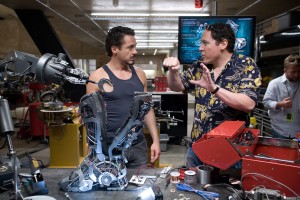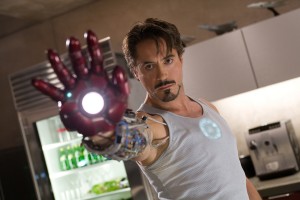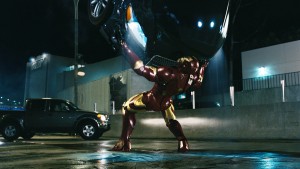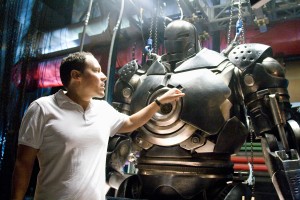Iron Man is a blockbuster hit due to a focus on acting, great action sequences and seamless big budget visual effects by lead facility Industrial Light and Magic, steered by visual effects supervisor John Nelson. Alongside ILM was The Orphanage and we drill down on just one aspect of the film – the Heads Up Display – in this week’s fxpodcast with designer Dav Rauch.
With a library of over 5,000 characters, Marvel Entertainment, Inc. is one of the world’s most prominent character-based entertainment companies. Marvel Studios’ Hollywood renaissance has been nothing short of spectacular, with record-breaking franchises such as Spider-Man, X-Men and The Fantastic Four, resulting in a string of eight consecutive #1 box office openings. Since 1998, Marvel films have grossed over $4.9 billion worldwide at the box office.
 Iron man is directed by Jon Favreau who previously directed Zathura A Space Adventure, Elf (2003), Made (2001). As an actor he appeared in Daredevil (2003), and was lead in Swingers (1996). As an aside he wrote script for Swingers on computer software given to him by his father. Jon is an alumnus of Chicago’s ImprovOlympic improvisation troupe. Fellow members include the late Chris Farley, Ian Gomez, Pat Finn, Tim Meadows, and Mike Myers.
Iron man is directed by Jon Favreau who previously directed Zathura A Space Adventure, Elf (2003), Made (2001). As an actor he appeared in Daredevil (2003), and was lead in Swingers (1996). As an aside he wrote script for Swingers on computer software given to him by his father. Jon is an alumnus of Chicago’s ImprovOlympic improvisation troupe. Fellow members include the late Chris Farley, Ian Gomez, Pat Finn, Tim Meadows, and Mike Myers.
Perhaps this strong background lead to his style of trying to achieve as much in camera as possible, even in heavy effects films. With Iron Man opening to approximately $200 million in the first week, his style also helps produce performances from the cast that resonates with audience. While Iron Man is not thought of as being a primary property such as a Spiderman, the films incredible success has already lead to the announcement of Iron Man 2. (Don’t leave the theatre until after the end credits).
Interestingly this is Marvel Studios’ first self-financed movie. The Budget is estimated to be between $140 (boxofficemojo.com) to $180 million (estimated, ew.com), and the film is distributed by Paramount. With Marvel now funding films, cross plot lines become much easier and Iron Man’s Tony Stark is already scheduled to make an appearance in the new Incredible Hulk.
Jon Favreau shot the film in California, as he felt that too many superhero films had been set on the East Coast, particularly in New York City. One of the primary studios used was the Playa Vista Studios in West Los Angeles. These studios date back to Howard Hughes, only fitting as the Tony Stark character was originally partly influenced by the real life Hughes.
 As always with Marvel properties, comic book writer Stan Lee, makes a cameo this time he appears with three blondes whom Tony Stark mistakes for Hugh M. Hefner. Lee later mentioned that it was his most enjoyable cameo.
As always with Marvel properties, comic book writer Stan Lee, makes a cameo this time he appears with three blondes whom Tony Stark mistakes for Hugh M. Hefner. Lee later mentioned that it was his most enjoyable cameo.
There are approximately 1,000 effects shots in the film with the majority of effects done by:
• Stan Winston (LA) – the suit
• ILM – the digital 2nd and third suits
• The Orphanage – the Heads Up Display (HUD) and other effects shots
• The Embassy Vancouver – whose 20 man team did 60 shots at the beginning of the film in the cave.
Heading all of this was the visual effects supervisor is John Nelson. Nelson an Oscar winner for Gladiator, is well known for producing very realistic visual effects, on an epic scale. A graduate of the University of Michigan, Nelson began his career as a commercial director, and was nominated six times for a Clio Award, winning the prestigious advertising award twice. In the area of features he was also nominated for a second Oscar for I Robot in 2004.
The graphical Heads Up Display (HUD) for the hi-tech suit of armor was designed by the Orphanage and Dav Mrozek Rauch. In this week’s podcast we talk to Dav Rauch about the design issues in making the graphical user interface of what became almost a separate character in the film, and about the year it took to perfect. That podcast is available by clicking in the top right of this window – or from iTunes.
Industrial Light & Magic made the second and third digital suits Iron as well as many of the flying sequences. On the back of Transformers in particular the director felt ILM was best placed to provide realistic effects. In some sequences the actor was filmed on set with a partial suit and ILM then added the rest of the suit digitally. Universally the ILM work is exceptional and flawless, from the lighting on the suits, to the complex interactions the work can not be visually separated from the live action components.
 “Jon Favreau is very much about invisible visual effects supporting the story,”says John Nelson. “We talked a lot about stressing what the suit could do and not just creating a shot to show off the effects. Jon had a sign over his office that said ‘plausibility,’ so that was our guideline in developing how we were approached the film from a visual effects standpoint.”
“Jon Favreau is very much about invisible visual effects supporting the story,”says John Nelson. “We talked a lot about stressing what the suit could do and not just creating a shot to show off the effects. Jon had a sign over his office that said ‘plausibility,’ so that was our guideline in developing how we were approached the film from a visual effects standpoint.”
“What I like to do is strike a balance that mixes the visual effects with practical effects so audiences start to forget where one begins and the other ends,”says Favreau. “Sometimes that means cutting from one shot of Iron Man wearing the real suit to another that’s completely a computer-generated image (CGI). What that does is force the people building the practical suit to make it move freely enough that you would believe it could be CGI, and it makes the CGI people honest because they have something practical to match it to.”
For Stan Winston’s Shane Mahan and his suit design team, this required making a suit that could be worn in sections over the visual effects suit Downey wore. “The big challenge was trying to find ways to blend, cross-cut and inter- cut combinations of practical and CGI shots,”says Mahan. “It would be absolutely foolish for me to think that I could pull off every shot in the practical suit, so we created a combination for Robert consisting of the chest piece, helmet and arm sections combined with a full-body motion capture tracking marker suit underneath. It’s a great way to blend the practical with the computer-generated effects, enabling ILM to bridge any gaps between the physical pieces.”
The Suit
The various suits in the film are central to the story and really need to communicate a lot as the actor is completely unseen, so there is no capacity for facial expression or acting. “Tony Stark takes on a different character when he’s wearing the suit and he’s able to do things he would never otherwise dream of doing. The suit gives him the personality of a hero and I really wanted the Mark III Armor to look like it just stepped out of the comic book and onto the big screen.” says Favreau.
Illustrator Phil Saunders recalls the initial design concept process for Iron Man’s Mark III armor: “Jon sent me a sketch he had commissioned Adi Granov to execute, which was an interpretation of the suit from ’The Extremist’ series of the comic book,”says Saunders. “Adi’s design was pretty amazing, but they’d been living with that design for quite some time and wanted the suit to have a little bit more of a stealth design. Whatever innovations I would come up with were sent to Adi, who would do an aesthetic pass on everything because he has a particular way of smoothing everything out and getting all the lines to flow with this beautiful proportion that everyone in the comic book world really admired.”
Saunders continues, “Once we got a design that was pretty solid, I did elevations of traditional three-view – top, side, front and back – illustrations of the suit that we then sent to Eddie Yang at Stan Winston Studios. He took those designs and used them as templates to build a 3-D model. Then both Adi and I worked with Eddie in refining every single surface to make sure that the proportions and the detailing matched the filmmakers’ vision of the suit.”
“Phil Saunders and Adi Granov did a fantastic job of finding the right proportions for the Mark III suit,”says executive producer D’ Esposito. “In the comic book industry there’s what is called ’heroic’ proportions – anywhere from eight to ten heads tall for a human figure. This looks fantastic in a comic book, but freakishly alien if translated literally into the film world. Jon was very concerned that the look of the suit be utterly convincing. When Tony Stark puts on this suit, he doesn’t just become a man in a powered suit, he becomes an iconic character, so it was very important for the suit itself to have a heroic level of personality as well as make us believe there’s actually a human being inside of it.”
With the design concept of the Mark III in place, Stan Winston Studios’ Shane Mahan began the process of building the suit.
Flying
Motion Capture was used for some sequences and Robert Downey Jr. actually returned months after principle photography to record motion capture performances. Not all the flying was done with CGI, some sequences such as Stark learning to fly were old school wire work. ZeroG provided an advanced wire rig that allowed actor Robert Downey Jr. to fly around his workshop in studio and provide one of the films most endearing scenes.
“I’ve done wire work both as an actor and a director, and even if you use computers to paint everything out, there’s something about the physics of it that is unconvincing to me,”says Favreau. “I was very skeptical if we could do any wire work at all because if you can see the pick points, it takes the audience out of the movie.”
The challenge of finding an alternative solution fell into the capable hands of stunt coordinator Tommy Harper, who brought in the company Zero G to build a state-of-the-art rig that would enable the filmmakers to avoid traditional wirework. “I already knew that Jon doesn’t like when its looks like an actor is being lifted by wires,”explains Harper. “So we came up with a new system that has what’s called an ’endless’ wire that goes through two pulleys in a bar above Robert’s head. That goes down through two more pulleys on his hips and into two platforms under his feet. So as his feet move, it moves above his head, and he can move independently because he is actually being lifted by his feet and not by his hips or back.”
The stuntman continues, “The problem with it is like doing isometrics. It’s very taxing on the legs and upper body, because it’s like holding yourself as rigid as you can for six or seven minutes. It’s very difficult, but Robert had been training in order to get his muscles toned for it. After the visual effects guys put in blasts from his hands and his feet, it will really look like he’s being propelled around.”
Iron Monger
 In addition to the three stages of the Iron Man suit, the bad guy gets one. This suit Iron Monger was practically built by Stan Winston Studios. It was 10 feet tall and weighed over 800 pounds. As the practical suit was so large and heavy, a clever system of using a gimbal was devised to simulate the suit walking. The primary suit required 5 operators to puppeteer. “We have had a couple of instances where we’ve been able to put both arms on and do manual puppeteering to accomplish shots as well. The Iron Monger wasn’t built as a hydraulic character, so it’s basically human muscle, a gimbal and our stuntmen making it work.”says Stan Winston’s Shane Mahan.
In addition to the three stages of the Iron Man suit, the bad guy gets one. This suit Iron Monger was practically built by Stan Winston Studios. It was 10 feet tall and weighed over 800 pounds. As the practical suit was so large and heavy, a clever system of using a gimbal was devised to simulate the suit walking. The primary suit required 5 operators to puppeteer. “We have had a couple of instances where we’ve been able to put both arms on and do manual puppeteering to accomplish shots as well. The Iron Monger wasn’t built as a hydraulic character, so it’s basically human muscle, a gimbal and our stuntmen making it work.”says Stan Winston’s Shane Mahan.
“I love how the Iron Monger suit echoed the Mark I suit,”says Favreau. “It felt like a machine and a living character at the same time. To see it built in real life was very helpful. I felt the scale of the thing as I stood before it. It was a very successful design and served as a terrific jumping-off point for the animators at ILM.”
For actress Paltrow, the physically menacing Iron Monger suit was quite impressive. “I couldn’t believe how big Iron Monger was when I was standing next to it,”laughs Paltrow. “I just think the whole effects thing is amazing – it’s like an art and a science at the same time.”
Offline
 One unusual aspect of the film is that the whole film as editing offline in HD using AVID’s DNxHD codec. The Editor was Dan Lebental, A.C.E. (previous credits include Jon Favreau’s family films Zathura, Elf,as well as Lucky McKee’s The Woods) says this decision was the outcome of the move by Marvel Entertainment to produce Iron Man, the upcoming The Incredible Hulk, and all future Marvel-related feature films itself. Marvel, therefore, built a temporary editing facility in Los Angeles and purchased several Avid Media Composer Adrenaline systems to cut its first two movies.
One unusual aspect of the film is that the whole film as editing offline in HD using AVID’s DNxHD codec. The Editor was Dan Lebental, A.C.E. (previous credits include Jon Favreau’s family films Zathura, Elf,as well as Lucky McKee’s The Woods) says this decision was the outcome of the move by Marvel Entertainment to produce Iron Man, the upcoming The Incredible Hulk, and all future Marvel-related feature films itself. Marvel, therefore, built a temporary editing facility in Los Angeles and purchased several Avid Media Composer Adrenaline systems to cut its first two movies.
Military
With the military having a strong presence in the script, the filmmakers felt it was vital to obtain DOD (Department of Defense) approval for the film. Producer Feige explains the process: “When you get DOD approval on a film, you get access to lots of cool planes and vehicles and other military assets. To obtain DOD approval, there is a submission process in which the script is submitted to the government and they read it and give you notes. Their main goal is to ensure that the characters associated with the Armed Forces, or the movie in general, personify the military in a somewhat favorable light. Obviously conflict is inherent in drama, but we were lucky to have the character of Rhodey in the film, a grounded, high-ranking Colonel in the Air Force who is upstanding and very heroic.”
As part of obtaining DOD approval, the production was assigned Air Force Captain Christian Hodge, who served as the department’s officer on the film. “Getting DOD approval for a film is huge thing,”explains Hodge. “When you have that kind of support from the military, it really takes the film to the next level because it allows you to film on active military bases and shoot in actual planes and vehicles, as well as use real military members as background. The production also gets an on-set technical advisor, which helps a great deal in making sure the film is realistic and accurate.”
The production managed to shoot at Edwards Air Force Base: “Edwards Air Force Base is the best back lot you could ever have,” the director asserts. “We had so many great assets at our disposal and every angle we shot in looked completely authentic – airplanes, desert, dry lakebeds, hangars. It really did a lot for the authenticity of
the film.”
“I remember looking at the frame and I said to one of the other producers, ‘My God, in the deep background they’re towing an F-16 through our shot,’”adds Peter Billingsley, Executive Producer. “Normally you might have a car or some extras crossing in the back of your frame to add a little production value, but because we had DOD approval, we have F-16’s. We also had actual members of the Army, Air Force, and Marines who were extras, which was great because it adds so much to the believability of the film.
